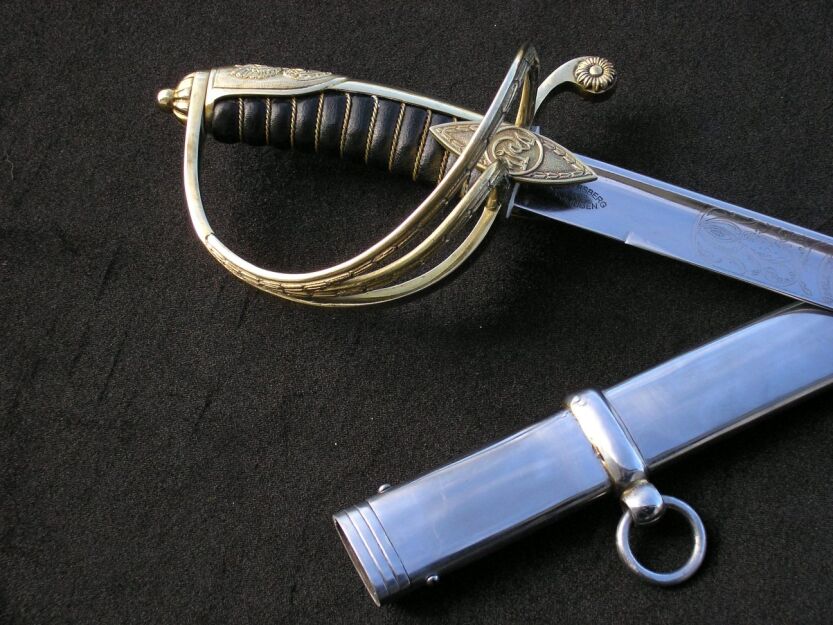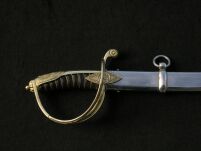



 Exists
Exists
The product is shipped within 24 hours.
We complete the order within 24 hours.
The product is covered by a one-year warranty.
You can return the product within 14 days.
Luxurious saber of Polish cavalry officer wz. 1917 PS-11
Copy of the historical model.
Luxurious saber. Henryk Sztorc's studio, according to the custom of the time, was called the Artistic-Cousin-Bronze Studio, was located in Krakow at ul. Floriańska 47. She specialized in church products. In the years 1916-1919, she provided legionnaires and soldiers of the resurgent Polish Army with elegant saber handles, eagles for caps, buttons and uniform badges. At that time, there were no producers of blades and scabbards in Krakow, so the bronzer could only remake foreign sabers, changing their hilt to Polish, and possibly engrave or etch ordered inscriptions or decorations.
ATTENTION. Forged and tempered model for light cutting force training.
The model has a blunt blade but is suitable for sharpening.
BLADE: HIGH CARBON STEEL 1060 FORGED AND HAND HARDENED (requires maintenance) HARDENING TO: 52-54 HRC
BLADE: engraved on both sides - one side with floral motifs Polish eagle in a crown, the other side with floral motifs and the Mother of God
Scabbard: steel - polished (requires maintenance). The scabbard is lined with leather inside. You can keep a saber in a scabbard without fear of corrosion.
Handle: brass
The handle with a wooden lining and trimmed with natural leather
In the notches of the handle, a braid of brass wire
HIGH FLEXIBILITY OF THE BLADES
Dimensions:
Total length in the scabbard: about 104 cm
The length of the saber without the scabbard: about 98 cm
Blade length: about 84 cm
Handle length: 14 cm
Blade thickness at the handle: 5 mm
The width of the blade at the handle: 2.8 cm
Weight with scabbard: about 1.76 kg
Weight without scabbard: about 1.070 kg
Scabbard weight: about 0.7 kg
Our model is a copy that is based on the saber described in the book by Paweł Komorowski.
FRAGMENT OF THE ORIGINAL DESCRIPTION BELOW:
"Closed hilt, gilded brass binding, decorated with a convex plant relief. Cross-bow guard with two side bows and ogival mustaches, the outer of which is decorated with a miniature commemorative badge of the 1st Regiment of Polish Legions. inclined towards the blade, decorated with a flower. The head is covered with a cap with an eagle in the crown, passing into a braid reaching the crossguard. On the head there is a rosette-shaped nut, fixing the pin of the blade. On the back shoulder of the crossguard, from the bottom, the stamped SZTORC / KRAKÓW signature.
A nickel-plated steel blade with a low curvature, flat ground amphibians with a roller-shaped spine. Feather with a bone formed from the shaft of the spine of the blade, point decentric. On the outer amphibian of the blade, at the base, there is a signature of the manufacturer WEYERSBERG / SOLINGEN, below, there is an etched gilded decor with a leaf motif and an eagle in a crown and the inscription ZA FAARĘ / I Fatherland. On the internal amphibian, also in plant decorations, there is a gilded cartouche depicting the image of the Virgin Mary with the Child and the inscription UNDER YOUR / DEFENSE. Polished steel scabbard with two grooves and movable wheels. Asymmetrical spur. The scabbard neck is channeled. "1.
1 - Fragment of the description of the model from the book by Paweł Komorowski: "We will not run short of sabers ... White weapons of the Polish soldier from the 18th-20th centuries" page 14, Oficyna Wydawnicza Kulawiak, Sylva-Opus Paweł Komorowski
A copy of the historical model presented in the book by Paweł Komorowski: "We will not run short of sabers ... White weapons of the Polish soldier from the 18th-20th centuries" page 14, Oficyna Wydawnicza Kulawiak, Sylva-Opus Paweł Komorowski